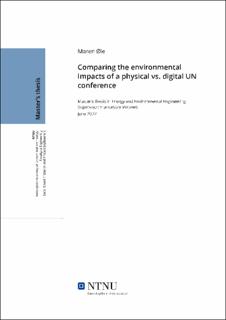| dc.contributor.advisor | Verones, Francesca | |
| dc.contributor.author | Øie, Maren | |
| dc.date.accessioned | 2022-09-14T17:19:51Z | |
| dc.date.available | 2022-09-14T17:19:51Z | |
| dc.date.issued | 2022 | |
| dc.identifier | no.ntnu:inspera:110284204:49840060 | |
| dc.identifier.uri | https://hdl.handle.net/11250/3017932 | |
| dc.description.abstract | I 2020 måtte de fleste internasjonale møter og konferanser enten avlyses eller gjennomføres digitalt på grunn av COVID-19 pandemien. Dette var også tilfellet for tusenvis av FN møter og konferanser. The Missions of Switzerland er fullstendig klar over de økonomiske kostnadene knyttet til digitale konferanser arrangert av FN, men det er usikkert hvilke miljøkostnader som er knyttet til de.
Resultatene av denne oppgaven viser at digitale konferanser har et lavere karbonfotavtrykk enn tilsvarende som gjennomføres fysisk. Digitale konferanser er imidlertid ikke fri for miljøpåvirkninger. Karbonfotavtryket ble beregnet for fem ulike scenarier av digitale og fysiske konferanser. Den funksjonelle enheten var en konferanseperiode på 3 uker med 47 deltakere. Resultatet viste at det å bytte fra en fysisk konferanse til en digital i gjennomsnitt reduserer karbonfotavtrykket med 90\%. De potensielle reduksjonene er i hovedsak knyttet til redusert forhåndsprintet materiale, bruk av konferanselokalet og behov for transport og hotellovernatting. Analysen viser at lokasjonen til deltakerne av konferansen har stor innvirkning på det totale karbonfotavtrykket forbundet med en digital konferanse. Årsaken er at energimiksen som benyttes er avgjørende for utslippene knyttet til bruk av IT-utstyret som kreves på konferanser.
Basert på denne kunnskapen bør arrangører etterstrebe det å arrangere mest mulig bærekraftige konferanser ved å ta i bruk den digitale versjonen. Videre kan det å bytte fra en fysisk konferanse til en hybridversjon både beholde fordelene med fysiske konferanser, samt redusere behovet for transport og hotellovernatting. Dersom arrangøren også er bevist når det gjelder valg av lokasjon, frekvens på konferansene, dataoverføring og bruk at IT utstyr, vil det være et stort potensial til å redusere konferansens karbonfotavtrykk. En overgang fra fysiske til digitale eller hybride konferanser krever et omfattende paradigmeskifte i hele konferansebransjen. | |
| dc.description.abstract | In 2020 most international meetings and conferences had to either cancelled or were carried out digitally due to the COVID-19 pandemic. This was also true for thousands of UN meetings and conferences. The Missions of Switzerland are fully aware of the economic costs implications of digital conferences, while there is ambiguity around the environmental costs.
The results of this thesis show that digital conferences have a lower carbon footprint associated than a comparable conference that is conducted physically. However, they are not without their share of impact on the environment. The carbon footprint was calculated for five different scenarios of digital and physical conferences. The functional unit was a conference period of 3 weeks with 47 participants. The result showed that making a conference digital instead of physical will on average reduce the carbon footprint by 90\%. This reduction is mainly caused by less printed material and no need for transport of participants or hotel accommodation. In addition, the location of the participants will be of great importance for the overall carbon footprint associated with a conference. The reason is that the energy mix used is decisive for the emissions associated with the use of IT equipment required for conferencing.
With this knowledge in mind, organisers should strive to arrange a sustainable conference by adopting the digital version of conferencing. Furthermore, switching from a physical conference to a hybrid version could both retain the benefits of physical conferencing and reduced need for transportation and hotel accommodation. If the organiser is also proven when it comes to choose of location, frequency of conferences, data distribution and use of IT equipment, there will be great potential in reducing the carbon footprint associated with the conference. Such transformation from physical to digital or hybrid conferences necessitates more than just calling on individual participants to reduce their carbon footprint. It requires instead a comprehensive paradigm shift towards decarbonisation throughout the conference industry. | |
| dc.language | eng | |
| dc.publisher | NTNU | |
| dc.title | Comparing the environmental impacts of a physical vs. digital UN conference | |
| dc.type | Master thesis | |
